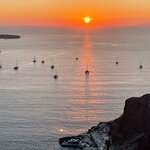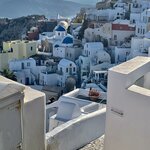Weather
Spring has arrived, with plenty of bright sunny days, crystal clear skies, and little rain. While Athens averages 68ºF (20ºC) Fahrenheit, the Cyclades, Dodecanese, and Crete are a degree or two warmer and may feel more like summer to visitors from northern climes. The Aegean and Ionian waters, however, haven’t yet warmed up and generally remain too cold for swimming in comfort. But this is a fabulous time for biking, hiking and other activities. Evenings can still be cool, so pack a fleece jacket along with your swimwear and sunscreen.
Crowds & Costs
A steady flow of visitors is now beginning to arrive—including the first tour groups—and cruise ships are beginning to show up at Santorini and other major islands. But you'll still be enjoying the Greek islands without the crowds of summer. Hotels generally charge shoulder season rates, offering bargains while they last. Note that during Easter week, hotel prices are higher and many restaurants, and most museums and archaeological sites, close.
Where to Go
In the most popular island venues, you’ll have the best of both worlds: relatively few visitors and mild sunny weather that seems tailor-made for sightseeing. This is a fabulous time to ferry-hop the islands, from Corfu to Crete, and the party scene is warming up on Ios, Mykonos, and Santorini without yet being rowdy.
Since it’s still too chilly for swimming comfortably and day-in, day-out sunning, focus your days on hiking, cultural activities, and sightseeing. Corfu hits all the check boxes, with its museums, pretty villages, and trails that lead through some of the islands’ most gorgeous landscapes. Easter is the perfect time to visit, when you can witness (and partake) in the local celebrations, such as pot-smashing on Holy Saturday.
Chat with a local specialist who can help organize your trip.
What to Do
Hikers are spoilt for choice: almost every island is laced with trails, while the isles are lush with green foliage and spring flowers blooming like crazy. In the Northern Aegean, Chios—"Homer’s homeland” and Greece’s fifth largest isle—is a dream ecotour destination. Combine a visit to the Mastic Museum (to learn about the isle’s aromatic gum) with hikes to the Byzantine monastery of Nea Moni, the black-sand beach at Mavra Volia, and Kampochora, where you can catch the wild tulips in short-lived bloom. At Easter, head to the village of Vrontados to witness the rouketopollemos (rocket war), when various churches fire rockets at each other!
April Events
Feast of St. George: Normally celebrated on April 23 (but on Easter Monday if Easter falls after that date), this Greek Orthodox ceremony is hosted at monasteries, churches, and rural communities—St. George was the patron of shepherds—with feasting and dancing.
Holy Week/Easter: Easter is the biggest religious festival of the Greek Orthodox calendar. Every island will have some festival, with lots of feasting and often ending with fireworks. Most museums and sites, plus many shops and some restaurants, close. Easter is preceded by Holy Week, which sometimes falls in March. Head to Chios to witness the unique “rocket war” fought between the village’s Eastern Orthodox churches.
Traveling to Greece in April? Check out these great itineraries
Cultural Cyclades – 13 Days. Combine four of the most popular islands—Naxos, Mykonos, Ios and Santorini—on this superb two-week exploration.
Discover Medieval Rhodes – 7 Days. Immerse yourself in this magnificent island, chock-full of historical sites and magnificent landscapes.
More Helpful Links
Greece in April
Best Time to Visit Greece
Greece Tours & Itineraries






